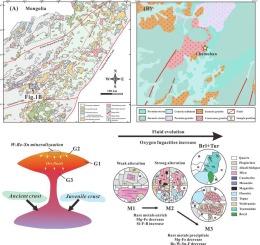大兴安岭南段察木汉W-Mo-Sn-Be矿床岩浆-热液演化与稀有金属成矿作用
IF 3.6
2区 地球科学
Q1 GEOLOGY
引用次数: 0
摘要
了解与花岗岩相关的脉状矿床的形成过程,对于理解岩浆-热液演化和花岗岩-热液系统中稀有金属的富集过程至关重要。本文的研究重点是阐明稀有金属成矿作用的控制机制和成矿流体的演化。研究了中国东北大兴安岭南段Chamuhan矿床花岗岩和石英脉中锆石-独居石-锡石-黑钨矿U-Pb年龄、全岩组成、独居石Nd同位素数据,以及云母、绿柱石和电气石的矿物学和化学数据。研究岩浆作用与成矿作用的时间和成因关系,评价稀有金属成矿作用的影响因素,阐明成矿流体的性质和演化。Chamuhan二长花岗岩(144 ~ 139 Ma)的U-Pb测年结果与成矿期(142 ~ 132 Ma)吻合较好,与其他晚侏罗世—早白垩世矿床的U-Pb测年结果一致,表明SGXR地区存在稀有金属成矿高峰。这一时期的伸展环境为岩浆演化提供了充足的时间,有利于稀有金属矿床的形成。成矿流体可能从下伏的细粒二长花岗岩(G3)中分离出来,表现出最高的演化程度和最强的熔融-流体相互作用,最终向蚀变侵入体(G2)顶部沉淀,形成W-Be-Sn矿化。热液云母、绿柱石和电气石的化学数据阐明了矿石流体的演化过程。这些流体从高浓度的Si、F和稀有金属,伴随低氧逸度和Mg-Fe含量转变为高氧逸度和B含量,伴随低稀有金属和低至中等盐度的条件。同位素地球化学表明,系统自冷而不是外部流体的加入导致了矿石矿物的沉淀。通过对同时期察穆罕、茅登和魏拉斯托三种稀有金属花岗岩全岩地球化学和单独居石Nd同位素数据的详细比较,发现产地稀有金属含量有限。Chamuhan矿床稀有金属异常富集可能是高度结晶分异、流体-熔体相互作用和熔体结构变化共同作用的结果。综上所述,本研究不仅为Chamuhan矿床的岩浆-热液演化提供了新的认识,而且还证明了云母、绿柱石和电气石可以作为有价值的找矿指标,其中稀有金属和F的浓度升高表明成矿可能性增加。本文章由计算机程序翻译,如有差异,请以英文原文为准。

Magmatic-hydrothermal evolution and rare metal mineralization in the Chamuhan W-Mo-Sn-Be deposit in the southern Great Xing’an Range, Northeastern China
Understanding the processes involved in the formation of vein-type deposits associated with granites is crucial for comprehending the magmatic-hydrothermal evolution and enrichment processes of rare metals in granitic-hydrothermal systems. The primary focus of this study is to elucidate the mechanism controlling rare metal mineralization and the evolution of ore-forming fluids. We present zircon-monazite-cassiterite-wolframite U-Pb ages, whole-rock compositions, monazite Nd isotopic data, as well as mineralogical and chemical data for mica, beryl, and tourmaline from granites and quartz veins in the Chamuhan deposit in the southern Great Xing’an Range (SGXR), northeastern (NE) China. Our objectives are to investigate the temporal and genetic relationships between magmatism and mineralization, assess the factors influencing the rare metal mineralization, and elucidate the properties and evolution of the ore-forming fluids. The U-Pb dating results for the Chamuhan monzogranite (144 ∼ 139 Ma) closely coincide with the mineralization period (142 ∼ 132 Ma), which, along with other Late Jurassic-Early Cretaceous deposits, indicate a peak in rare metal mineralization in the SGXR. During this epoch, an extensional environment provided sufficient time for magma evolution and facilitated the formation of these rare metal deposits. The ore fluids likely separated from the underlying fine-grained monzogranites (G3), which exhibited the highest degree of evolution and strongest melt-fluid interaction, ultimately precipitating towards the top of the altered intrusion represented by the altered biotite monzogranites (G2), thereby forming the W-Be-Sn mineralization. The chemical data for hydrothermal mica, beryl, and tourmaline elucidate the evolution processes of the ore fluids. These fluids transition from high concentrations of Si, F, and rare metals, accompanied by low oxygen fugacities and Mg-Fe contents, to conditions characterized by high oxygen fugacities and B contents with low rare metals and low to medium salinities. Isotope geochemistry indicates that system self-cooling rather than addition of external fluids, led to the precipitation of ore minerals. Detailed comparisons of whole-rock geochemical and monazite Nd isotopic data among the coeval Chamuhan, Maodeng, and Weilasituo rare metal granites reveal that the source regions offer limited concentrations of rare metals. The abnormal enrichment of rare metals in the Chamuhan deposit is probably the result of a combination of high degrees of crystallization differentiation, fluid-melt interactions, and changes in melt structures. Overall, our study not only provides new insights into the refined magmatic-hydrothermal evolution of the Chamuhan deposit, but also demonstrates that mica, beryl, and tourmaline can serve as valuable indicators for mineral prospecting, where elevated concentrations of rare metals and F suggest an increased likelihood of mineralization.
求助全文
通过发布文献求助,成功后即可免费获取论文全文。
去求助
来源期刊

Ore Geology Reviews
地学-地质学
CiteScore
6.50
自引率
27.30%
发文量
546
审稿时长
22.9 weeks
期刊介绍:
Ore Geology Reviews aims to familiarize all earth scientists with recent advances in a number of interconnected disciplines related to the study of, and search for, ore deposits. The reviews range from brief to longer contributions, but the journal preferentially publishes manuscripts that fill the niche between the commonly shorter journal articles and the comprehensive book coverages, and thus has a special appeal to many authors and readers.
 求助内容:
求助内容: 应助结果提醒方式:
应助结果提醒方式:


